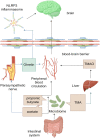The role of gut microorganisms and metabolites in intracerebral hemorrhagic stroke: a comprehensive review
- PMID: 38449739
- PMCID: PMC10915040
- DOI: 10.3389/fnins.2024.1346184
The role of gut microorganisms and metabolites in intracerebral hemorrhagic stroke: a comprehensive review
Abstract
Intracerebral hemorrhagic stroke, characterized by acute hemorrhage in the brain, has a significant clinical prevalence and poses a substantial threat to individuals' well-being and productivity. Recent research has elucidated the role of gut microorganisms and their metabolites in influencing brain function through the microbiota-gut-brain axis (MGBA). This article provides a comprehensive review of the current literature on the common metabolites, short-chain fatty acids (SCFAs) and trimethylamine-N-oxide (TMAO), produced by gut microbiota. These metabolites have demonstrated the potential to traverse the blood-brain barrier (BBB) and directly impact brain tissue. Additionally, these compounds have the potential to modulate the parasympathetic nervous system, thereby facilitating the release of pertinent substances, impeding the buildup of inflammatory agents within the brain, and manifesting anti-inflammatory properties. Furthermore, this scholarly analysis delves into the existing dearth of investigations concerning the influence of gut microorganisms and their metabolites on cerebral functions, while also highlighting prospective avenues for future research.
Keywords: NLRP3 inflammasome; ghrelin; intracerebral hemorrhage; microbiota-gut-brain axis; short-chain fatty acids; trimethylamine N-oxide.
Copyright © 2024 Wen, Dong and Zou.
Conflict of interest statement
The authors declare that the research was conducted in the absence of any commercial or financial relationships that could be construed as a potential conflict of interest.
Figures
Similar articles
-
NLRP3 inflammasome and gut microbiota-brain axis: A new perspective on white matter injury after intracerebral hemorrhage.Neural Regen Res. 2026 Jan 1;21(1):62-80. doi: 10.4103/NRR.NRR-D-24-00917. Epub 2025 Jan 29. Neural Regen Res. 2026. PMID: 39885662 Free PMC article.
-
The emerging role of microbiota derived SCFAs in neurodegenerative disorders.Brain Behav Immun Health. 2025 May 7;46:101012. doi: 10.1016/j.bbih.2025.101012. eCollection 2025 Jul. Brain Behav Immun Health. 2025. PMID: 40502529 Free PMC article. Review.
-
Gut-Lung Axis in Focus: Deciphering the Impact of Gut Microbiota on Pulmonary Arterial Hypertension.J Pers Med. 2023 Dec 20;14(1):8. doi: 10.3390/jpm14010008. J Pers Med. 2023. PMID: 38276223 Free PMC article. Review.
-
Interplay between Gut Microbiota and NLRP3 Inflammasome in Intracerebral Hemorrhage.Nutrients. 2022 Dec 9;14(24):5251. doi: 10.3390/nu14245251. Nutrients. 2022. PMID: 36558410 Free PMC article. Review.
-
Gut macrobiotic and its metabolic pathways modulate cardiovascular disease.Front Microbiol. 2023 Sep 26;14:1272479. doi: 10.3389/fmicb.2023.1272479. eCollection 2023. Front Microbiol. 2023. PMID: 37822750 Free PMC article. Review.
Cited by
-
Multimodal Interventions Targeting Gut Microbiota and Microbial Metabolites in Cognitive Impairment.Cureus. 2025 Jun 10;17(6):e85688. doi: 10.7759/cureus.85688. eCollection 2025 Jun. Cureus. 2025. PMID: 40642664 Free PMC article. Review.
-
Gut Microbiota, Bacterial Translocation, and Stroke: Current Knowledge and Future Directions.Biomedicines. 2024 Dec 6;12(12):2781. doi: 10.3390/biomedicines12122781. Biomedicines. 2024. PMID: 39767686 Free PMC article. Review.
-
NLRP3 inflammasome and gut microbiota-brain axis: A new perspective on white matter injury after intracerebral hemorrhage.Neural Regen Res. 2026 Jan 1;21(1):62-80. doi: 10.4103/NRR.NRR-D-24-00917. Epub 2025 Jan 29. Neural Regen Res. 2026. PMID: 39885662 Free PMC article.
-
Postbiotics as Molecules Targeting Cellular Events of Aging Brain-The Role in Pathogenesis, Prophylaxis and Treatment of Neurodegenerative Diseases.Nutrients. 2024 Jul 12;16(14):2244. doi: 10.3390/nu16142244. Nutrients. 2024. PMID: 39064687 Free PMC article. Review.
References
Publication types
LinkOut - more resources
Full Text Sources


